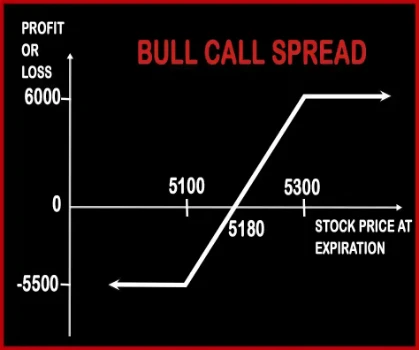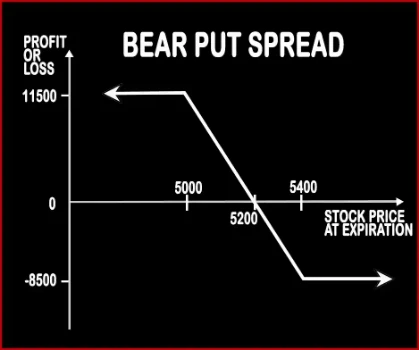Compare Strategies
| BULL CALL SPREAD | BEAR PUT SPREAD | |
|---|---|---|

|

|
|
| About Strategy |
Bull Call Spread Option StrategyBull Call Spread option trading strategy is used by a trader who is bullish in nature and expects the underlying asset to give decent returns in the near future. This strategy includes buying of an ‘In The Money’ Call Option and selling of ‘Deep Out Of the Money’ Call Option of the same underlying asset and the same expiration date. |
Bear Put Spread Option StrategyWhen a trader is moderately bearish on the market he can implement this strategy. Bear-Put-Spread involves buying of ITM Put Option and selling of an OTM Put Option. If prices fall, the ITM Put option starts making profits and the OTM Put option also adds to profit at a certain extent if the expiry price stays above the OTM strike. However, if it falls below the OTM .. |
BULL CALL SPREAD Vs BEAR PUT SPREAD - Details
| BULL CALL SPREAD | BEAR PUT SPREAD | |
|---|---|---|
| Market View | Bullish | Bearish |
| Type (CE/PE) | CE (Call Option) | PE (Put Option) |
| Number Of Positions | 2 | 2 |
| Strategy Level | Beginners | Advance |
| Reward Profile | Limited | Limited |
| Risk Profile | Limited | Limited |
| Breakeven Point | Strike price of purchased call + net premium paid | Strike Price of Long Put - Net Premium |
BULL CALL SPREAD Vs BEAR PUT SPREAD - When & How to use ?
| BULL CALL SPREAD | BEAR PUT SPREAD | |
|---|---|---|
| Market View | Bullish | Bearish |
| When to use? | This strategy is used when an investor is Bullish in the market but expect the underlying to gain mildly in near future. | The bear call spread options strategy is used when you are bearish in market view. The strategy minimizes your risk in the event of prime movements going against your expectations. |
| Action | Buy ITM Call Option, Sell OTM Call Option | Buy ITM Put Option, Sell OTM Put Option |
| Breakeven Point | Strike price of purchased call + net premium paid | Strike Price of Long Put - Net Premium |
BULL CALL SPREAD Vs BEAR PUT SPREAD - Risk & Reward
| BULL CALL SPREAD | BEAR PUT SPREAD | |
|---|---|---|
| Maximum Profit Scenario | (Strike Price of Call 1 - Strike Price of Call 2) - Net Premium Paid | Max Profit = Strike Price of Long Put - Strike Price of Short Put - Net Premium Paid. |
| Maximum Loss Scenario | Net Premium Paid | Max Loss = Net Premium Paid. |
| Risk | Limited | Limited |
| Reward | Limited | Limited |
BULL CALL SPREAD Vs BEAR PUT SPREAD - Strategy Pros & Cons
| BULL CALL SPREAD | BEAR PUT SPREAD | |
|---|---|---|
| Similar Strategies | Collar | Bear Call Spread, Bull Call Spread |
| Disadvantage | • Limited profit potential to the higher strike call sold if the underlying stock price rises. • Maximum profit only if stock rises to the higher of 2 strike prices selected. | • Limited profit. • Early assignment risk. |
| Advantages | • Allows you to reduce risk and cost of your investment. • When placing the spread, exit strategy is pre-determined in advance. • Risk is limited to the net premium paid. | • If the strike price, expiration date or underlying stocks are rightly chosen then risk of losses would be limited to the net premium paid. • This strategy works well in declining markets. • Limited risk. |